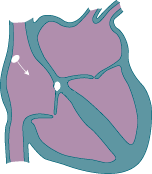Atrioventricular Heart Block
Heart block occurs when the electrical impulses that make the heart beat do not transmit normally. Normally, these impulses travel from the heart's upper chambers, called the atria, to the lower chambers, called the ventricles, through the atrioventricular (AV) node. In heart block, the AV node may be damaged from surgery, medications or congenital heart conditions. Heart block affects the heart's ability to pump blood and the body's blood pressure, and can cause an abnormally slow heart rhythm called bradycardia. An implanted artificial pacemaker can restore a normal heart rate and rhythm.
 Heart block may cause the following symptoms:
Heart block may cause the following symptoms:
- Chest pressure or pain
- Fainting, also known as syncope, or near-syncope
- Fatigue
- Lightheadedness or dizziness
- Palpitations, which can be skipping, fluttering or pounding in the chest
- Shortness of breath
It is important to note that during a period of heart block, children may not know how to describe what they are feeling. They may have trouble keeping up with other children or realize they are having "spells" and want to sit down and rest. Sometimes, a child does not experience any symptoms at all.
Heart block may occur spontaneously with unpredictable timing. Therefore, in some cases, specialized tests may be needed to make an accurate diagnosis. If your doctor suspects that your child has heart block, he or she will order one or more of the following diagnostic tests to determine the cause of your child's symptoms.
- Electrocardiogram (ECG or EKG) - An ECG records the heart's electrical activity. Small patches called electrodes are placed on your child's chest, arms and legs, and are connected by wires to the ECG machine. The electrical impulses of your child's heart are translated into a graph or chart, enabling doctors to determine the pattern of electrical current flow in the heart and to diagnose arrhythmias.
- Electrophysiology (EP) Study - In an EP study, doctors insert special electrode catheters - long, flexible wires - into veins and guide them into the heart. These catheters sense electrical impulses and also may be used to stimulate different areas of the heart. Doctors can then locate the sites that are causing arrhythmias. The EP study allows doctors to examine an arrhythmia under controlled conditions and acquire more accurate, detailed information than with any other diagnostic test.
- Exercise Stress Test - An exercise stress or treadmill test records the electrical activity of your child's heart during exercise, which differs from the heart's electrical activity at rest.
- Event Monitor - This is a small monitor about the size of a pager that your child can have for up to a month. Since the arrhythmia may occur at unpredictable times, this will help to record the abnormal rhythm when your child is experiencing symptoms. He or she can just push a button on the pager and record the heartbeat. The recording can then be transmitted by phone to the doctor.
- Holter Monitor - A Holter monitor is a small, portable machine that your child wears for 24 hours. It is about the size of a portable tape player and provides a continuous 24-hour recording of your child's heartbeat onto a tape. You will be asked to keep a diary of your child's activities and symptoms. This monitor may detect arrhythmias that might not show up on a resting electrocardiogram, which only records a heartbeat for a few seconds at rest.
Heart block can be treated with the implantation of a permanent pacemaker, which regulates the heart beat. It consists of two parts - the generator and the lead. The generator is a small metal container with a battery and tiny computer. The lead is an insulated wire that carries electrical impulses to the heart to ensure a stable heartbeat.
The computer in the pacemaker is constantly monitoring your child's heartbeat. This is called sensing. When the pacemaker senses your child's heartbeat, it continues to monitor your child's heart and does not send a signal to stimulate the heart to beat. However, if no electrical impulse is detected by the pacemaker, it sends out a signal to stimulate your child's heart to beat.
For information on how a pacemaker is implanted, please see Pediatric Pacemaker Procedure.
